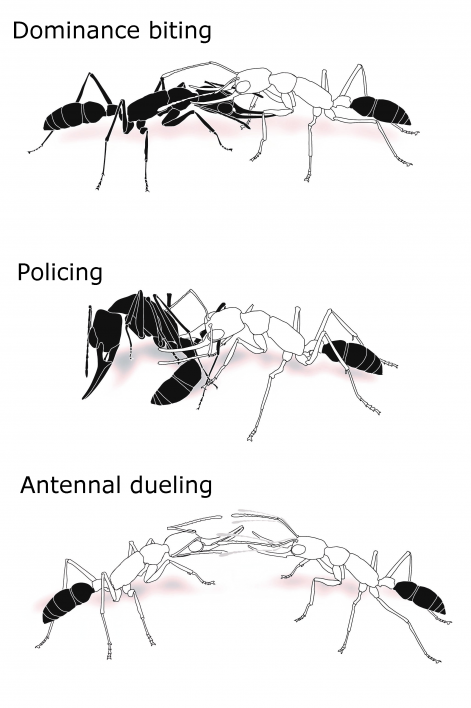New research solves enigma in ant communication

One ant dominates another by biting the head. Photo by Juergen Liebig
In many animal species, physical battles and other aggressive acts determine a certain “pecking order.” In the world of ants, fights that involve biting and restraining often determine winners and losers.
But what about battles that do not result in a pecking order, but instead lead to groups of winners and losers? Does this require a new type of aggressive interaction?
“We were curious as to whether dueling behavior in ants results in a winner and a loser, or if it is a winner-winner interaction that allows workers to express aggression without requiring a loser,” said Jürgen Liebig, associate professor at Arizona State University’s School of Life Sciences and senior author of a new study published in the current online issue of American Naturalist.
To help answer this question, the researchers developed a new computer model to manipulate several ant behaviors and to see how they affected the social structure of a colony. This model explains the complexity and diversity of social hierarchies in ants.
The scientists began by examining the behaviors and social hierarchy of the Indian jumping ant (Harpegnathos saltator). When a colony’s queen dies, the female workers engage in ritual fights to establish dominance. Although these battles can be fierce, they rarely result in physical injury to the worker ants. Ultimately, a group of approximately 10 workers will establish dominance and become a cadre of worker queens called “gamergates.”
A social hierarchy like this is called a “shared-dominance hierarchy.” Other ant societies establish pecking orders in which one individual is dominant and all others share a subordinate status.
The researchers identified three behaviors related to establishing a hierarchy in this ant species: biting, in which one ant bites another’s head, has a clear winner and loser, with the winner establishing dominance; policing, in which subordinate workers restrain challengers to a dominant individual; and dueling, in which two individuals engage in a martial display with their antennae, but which has no clear loser.
When biting was present, but policing and dueling were absent, the model resulted in a linear hierarchy with one dominant individual. When biting and strong policing were present, the model resulted in a despotic hierarchy with a single dominant individual. It was only when biting, policing and winner-winner dueling were all present that the model resulted in a shared-dominance hierarchy.
“We see examples of all three types of social hierarchies in various ant species, but we also see them throughout the animal kingdom and we know that shared-dominance hierarchies can be found in animal societies from lions to dolphins,” said Clint Penick, postdoctoral researcher at North Carolina State and lead author of the study. “We think the presence or absence of winner-winner behaviors may be an important factor in determining the nature of dominance hierarchies for a wide variety of species.”
Other authors of the study include: Takao Sasaki, co-lead author with University of Oxford; and Zachary Shaffer, Kevin Haight and Stephen Pratt of Arizona State University.
Three behaviors used to establish a shared-dominance hierarchy in Indian jumping ant colonies. Image by Clint Penick
More Science and technology

Science meets play: ASU researcher makes developmental science hands-on for families
On a Friday morning at the Edna Vihel Arts Center in Tempe, toddlers dip paint brushes into bright colors, decorating paper…

ASU water polo player defends the goal — and our data
Marie Rudasics is the last line of defense.Six players advance across the pool with a single objective in mind: making sure that…

Diagnosing data corruption
You are in your doctor’s office for your annual physical and you notice the change. This year, your doctor no longer has your…


